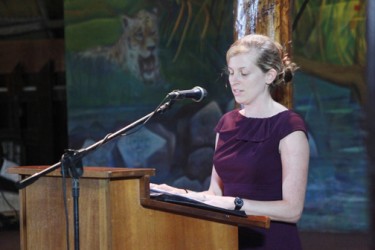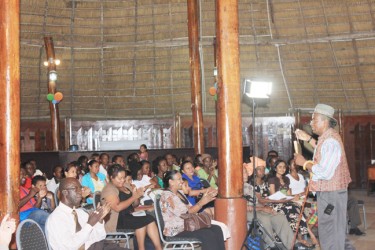World Story-telling Day is celebrated across the globe in several different countries. What started in Sweden in 1990 or 1991 (the records are not specific) as an organised event faded out and became sporadic before it gained sufficient recognition to be an annual event observed in several countries annually on March 20, as it now is. Its equivalent, World Poetry Day on March 21, is older (circa 1934), more established and better documented.
 Since 2011, the Department of Culture in the Ministry of Culture, Youth and Sport has staged an annual programme to observe the day during which performers and representatives of several different countries read selections of stories taken from Guyana and the international community. This year’s event held in Georgetown was ‘An Evening of International, Regional, and Guyanese Stories’ in which the readings had a distinct theatrical quality, revealing remarkable dramatic ability and an understanding of literature among the local and diplomatic communities.
Since 2011, the Department of Culture in the Ministry of Culture, Youth and Sport has staged an annual programme to observe the day during which performers and representatives of several different countries read selections of stories taken from Guyana and the international community. This year’s event held in Georgetown was ‘An Evening of International, Regional, and Guyanese Stories’ in which the readings had a distinct theatrical quality, revealing remarkable dramatic ability and an understanding of literature among the local and diplomatic communities.

An infinite variety of tales, preoccupations, themes and colour was performed in that programme and these will need to be dealt with later in greater depth, but the concentration here will be on just one category of Guyanese narratives. This focus will help to fulfil the purposes of World Storytelling Day, which is designed to promote the art of oral storytelling, preserve tales and their traditions, and help different nations and peoples to tell their stories and share their experiences.
Each year, World Storytelling Day has a theme, and for 2013 it was ‘Fate and Fortune’. That theme is a very relevant one when one reflects on the fate and fortunes of one of the most interesting varieties of Guyanese folk stories: the Balgobin Tales.
Balgobin is a Guyanese folk or culture hero; a fictional character who is the hero of a considerable corpus of stories popularly told among Guyanese. He has a character and qualities peculiar to his Guyanese type but not uncommon among other known folktale characters in the Caribbean. The most outstanding thing about the Balgobin tradition, however, is that it is surprisingly little known, relatively unresearched and threatened.
This fairly unhealthy state evokes irony and surprise because Balgobin stories are popular and when told, are passed around for entertainment and unbridled humour. Although the hero and the cast of characters are East Indian, they are known by and circulate among mixed audiences and are not confined to any one racial group. Furthermore, the Balgobin folktale tradition is clearly among the neatest, most skintight portraits of a people, and the most definitive and characteristic dramatisations of a people among the few East Indian narrative traditions that have survived. Documen-tation is scarce, although two attempts to correct this exist. Petamber Persaud has published The Balgobin Saga (Hansib, 2008) and final-year students of the Centre for Communication Studies University of Guyana have produced a short film (2012) which records and dramatises Balgobin. The latter is the effort of persons new to the subject and a laudable beginning. The former is the work of one much more experienced, rooted and involved, but is an edited and personalised account.

These stories and their traditions survive through continuous oral transmission over time and place – if they are told by people down the years; across geographical boundaries; from one generation to the next and from one district to another. That will guarantee popular survival. But there are also the irreplaceable factors of research and documentation, and these still need to be scientifically and systematically done. For example, more work may reveal curious issues concerning origins, including how and when the character/hero evolved.
Who is Balgobin? The answer is factually unknown, but a great deal may be discerned from textual evidence – that is the actual content of the stories. Really that is all we have to go by, but it is generally reliable, particularly because it largely coincides with what we know about the social history. In addition to that, those acquainted with folklore studies may use the evidence from examining the morphology of the tales: how they are structured and formed and the kinds of types and categories in which they may be placed.
Balgobin is a fictitious British Guianese schoolboy attending what seems to be a public primary school in post-indentureship colonial times. His age is never mentioned; he is the school dunce, both celebrated and jeered by his classmates for the distinction of being almost never able to give the right answers or to betray any hint of scholarship. Yet he possesses wisdom beyond his years, which makes him sometimes appear much older. He is able to defeat all who come before him – mainly the teacher, the inspector of schools and his classmates – with his knowledge, common sense, quick thinking, ingenuity and wit. The enduring irony is that despite his reputation of academic inability, he is always the most knowledgeable and always outwits everyone.
Balgobin belongs to a rural Guianese East Indian community with the characteristics of such a community in a colonial estate setting. He is poor, with parents who are most likely estate workers or members of the poor peasantry. He is the champion of his unprivileged social class because of his quick wit and ability to best those with academic brilliance or the visiting school inspector. He is known only as Balgobin – having a single name quite within the Guyanese Indian experience. The entire cast of characters is Indian and the stories fit very neatly into that setting.
The Balgobin Tales fall into a number of categories of Guyanese folk narratives. First, they are jocular tales – or jokes – because the stories are brief with a strong punch-line. They are humorous. Some of them have a sexual sub-text (rather than blatant sexual content), and all these go together to make them popular entertainment. They are often told as jokes.
They also belong to the trickster tradition which is common in folk tales. The culture hero or folk hero employs his wits as a survival mechanism or a weapon of war much in the way of the (in)famous Anansi (Anancy). Balgobin often acts as a champion for his people in similar fashion although he does not have the vices of Anansi. Balgobin often uses his quick wit to get himself out of tight spots.
But these tales are also satires of the colonial class, social and education system. They ridicule the so-called superiority of academic knowledge which is always outdone by Balgobin’s commonsense. These stories are currently being collected in the field by students of Oral Literature at the University of Guyana, and the majority of them are set in the classroom or in a school situation. Officialdom, (the Schools Inspector and sometimes the teacher) are repeatedly ridiculed or shown as inferior to a consciousness that was not shaped by the system. This is a consciousness that is considered a failure by the system, but a consciousness that is superior to it and which most likely was failed by it. It is the system, then, that is the failure. The Balgobin tales may be analysed as post-colonial texts offering a critique of a society in which there is vicarious triumph by an unprivileged underdog. Neither is it accidental that education is the main theme. Balgobin supposedly lacks education yet he is in the centre of an educational environment that is failing him and lording it over them with his native wit.
A close equivalent of Balgobin in other similar jocular narratives is Big Boy in the Big Boy jokes or stories of Jamaica. Big Boy (a black Jamaican) is precocious, thus his name – he is supposed to be a little boy, perhaps the same age as Balgobin, but is “big” for his age. He is worldly wise and most Big Boy stories are sexual in content. Collections from the field in both the Guyanese and the Jamaican traditions suggest that it is likely that jokes are made up, or jokes that did not originate with either Balgobin or Big Boy are attached to them and thereafter passed off as their stories. A couple of stories known in Jamaica as Big Boy jokes have been found in Guyana among Balgobin tales.
Among the most impressive and representative of Balgobin tales is the following:
That day Teacher was teaching the class Arithmetic.
She calls out, “Chandrani. Tell me – if 30 sheep in a pen and ten get away through an opening in the fence, how much you have left?”
Chandrani says “20, Teacha”.
“Brilliant, Chandrani. Now Vidiadhar. If 20 sheep in the pen and three get way through a opening in the fence, how much left?”
Vidiadhar jumps up, “17, Teacha”.
“Oh, that was good, Vidiadhar, you are very bright”.
Teacher then turns to Balgobin. She says “Okay, Balgobin, you tell me. 25 sheep in a pen and one get way through an opening in the fence. How much left inside?”
Balgobin answers “None, Teacha”.
Teacher exercises some patience. “All right, Balgobin, try again. Listen good. 25 sheep in a pen and one get way through the opening in the fence. How much left inside?”
Balgobin answer again “None, Teacha”.
“Balgobin, wha wraang to yu? Look how Chandrani an Vidiadhar get it right. How come them know the answer an you can’t get it, Balgobin? Wha wraang to yu?”
Balgobin say “Teacha, them know ritmitic, but me know sheep”.









